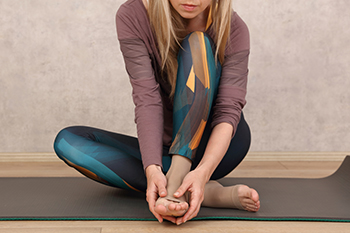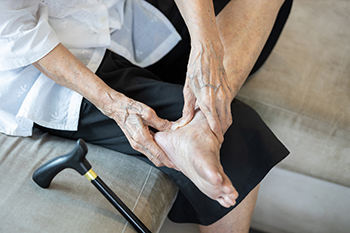Call Us Today! (203) 975-9600
SAME DAY APPOINTMENTS AVAILABLE
August 2022
Diabetes and Poor Circulation Often Go Hand in Hand
 People with diabetes can also suffer from peripheral arterial disease (PAD). This is a disease in which elevated blood glucose levels cause your arteries to narrow. A narrowing of the arteries can restrict the flow of blood to the extremities, otherwise known as poor circulation. PAD symptoms include numb or cold feet, intermittent claudication (leg pain that goes away when resting), bluish colorization in the skin of the legs, loss of hair on the legs or feet, brittle toenails and more. One of the more serious symptoms of PAD is an impaired ability to heal wounds and sores, which can be potentially dangerous for the diabetic patient. As a diabetic, it is wise to be under the care of a podiatrist. They will be able to determine if you have PAD with a non-invasive test of the blood flow in your feet called a brachial pressure index test, or ABPI test. If you have been diagnosed with PAD, your podiatrist will be able to help manage your symptoms and help prevent complications from arising.
People with diabetes can also suffer from peripheral arterial disease (PAD). This is a disease in which elevated blood glucose levels cause your arteries to narrow. A narrowing of the arteries can restrict the flow of blood to the extremities, otherwise known as poor circulation. PAD symptoms include numb or cold feet, intermittent claudication (leg pain that goes away when resting), bluish colorization in the skin of the legs, loss of hair on the legs or feet, brittle toenails and more. One of the more serious symptoms of PAD is an impaired ability to heal wounds and sores, which can be potentially dangerous for the diabetic patient. As a diabetic, it is wise to be under the care of a podiatrist. They will be able to determine if you have PAD with a non-invasive test of the blood flow in your feet called a brachial pressure index test, or ABPI test. If you have been diagnosed with PAD, your podiatrist will be able to help manage your symptoms and help prevent complications from arising.
While poor circulation itself isn’t a condition; it is a symptom of another underlying health condition you may have. If you have any concerns with poor circulation in your feet contact one of our podiatrists of Preferred Footcare, LLC. Our doctors will treat your foot and ankle needs.
Poor Circulation in the Feet
Peripheral artery disease (PAD) can potentially lead to poor circulation in the lower extremities. PAD is a condition that causes the blood vessels and arteries to narrow. In a linked condition called atherosclerosis, the arteries stiffen up due to a buildup of plaque in the arteries and blood vessels. These two conditions can cause a decrease in the amount of blood that flows to your extremities, therefore resulting in pain.
Symptoms
Some of the most common symptoms of poor circulation are:
- Numbness
- Tingling
- Throbbing or stinging pain in limbs
- Pain
- Muscle Cramps
Treatment for poor circulation often depends on the underlying condition that causes it. Methods for treatment may include insulin for diabetes, special exercise programs, surgery for varicose veins, or compression socks for swollen legs.
As always, see a podiatrist as he or she will assist in finding a regimen that suits you. A podiatrist can also prescribe you any needed medication.
If you have any questions, please feel free to contact our office located in Stamford, CT . We offer the newest diagnostic and treatment technologies for all your foot care needs.
Possible Preventive Techniques for Cracked Heels

The medical condition known as cracked heels can be uncomfortable. If the cracks in the skin are deep, they are referred to as fissures, and may bleed. It is an ailment that affects the heels, and it is generally caused by having excessively dry skin. This can be a result of the aging process, from wearing shoes that do not have a back, or from standing on hard surfaces for most of the day. There may be existing medical conditions that can lead to cracked heels, including eczema, psoriasis, a thyroid disorder, or a vitamin deficiency. People who are overweight may experience cracked heels, and this can be a result of the added weight the feet must endure. Some of the symptoms associated with cracked heels include flaky skin, bleeding, pain and discomfort. An effective prevention technique includes washing and drying the feet daily followed by applying a good moisturizer. Additionally, it may help to refrain from standing in one position for long periods of time and to wear shoes that have a back. If you have cracked heels, a podiatrist can prescribe effective medicine that can help to manage this condition, and it is suggested that you schedule an appointment.
If the skin on your feet starts to crack, you may want to see a podiatrist to find treatment. If you have any concerns, contact one of our podiatrists from Preferred Footcare, LLC. Our doctors can provide the care you need to keep you pain-free and on your feet.
Cracked Heels
It is important to moisturize your cracked heels in order to prevent pain, bleeding, and infection. The reason cracked heels form is because the skin on the foot is too dry to support the immense pressure placed on them. When the foot expands, the dry skin on the foot begins to split.
Ways to Help Heal Them
- Invest in a good foot cream
- Try Using Petroleum Jelly
- Ease up on Soaps
- Drink Plenty of Water
Ways to Prevent Cracked Heels
- Moisturize After Showering
- Skip a Shower
- Keep Shower Water Lukewarm
- Don’t Scrub Your Feet
If you are unsure how to proceed in treating cracked heels, seek guidance from a podiatrist. Your doctor will help you with any questions or information you may need.
If you have any questions, please feel free to contact our office located in Stamford, CT . We offer the newest diagnostic and treatment technologies for all your foot care needs.
Are You Suffering From Ingrown Toenails?
Baby Foot Care

Feet are critical parts of everyone’s body and babies are certainly no exception. If you are caring for a baby, there are several steps that you can take to ensure that their feet are healthy and taken care of. First, baby feet should not be physically restrained or restricted because physical activity and movement are what enable the baby’s feet to grow and develop. For example, when a baby kicks their feet, they are developing muscles in their feet. Second, ensure that any foot coverings your baby is wearing fit correctly. If your baby is wearing socks or booties when they are taken outside in cold weather, it might be smart to check regularly that they are not too tight. A baby’s body grows and develops at an astounding rate. Therefore, what fits a baby’s feet one month may not fit next month. Third, it can also be wise to regularly wash your baby’s feet to make sure that they are perfectly clean. However, if you do give your baby a foot bath be sure to completely dry their feet. If the feet are not dried properly, they could become soggy, which might create complications. If you are taking care of a baby, do not take any chances with the health of their feet. Contact your podiatrist for more tips and tricks about caring for baby feet.
Making sure that your children maintain good foot health is very important as they grow. If you have any questions, contact one of our podiatrists of Preferred Footcare, LLC. Our doctors can provide the care you need to keep you pain-free and on your feet.
Keeping Children's Feet Healthy
Having healthy feet during childhood can help prevent medical problems later in life, namely in the back and legs. As children grow, their feet require different types of care. Here are some things to consider...
Although babies do not walk yet, it is still very important to take care of their feet.
Avoid putting tight shoes or socks on his or her feet.
Allow the baby to stretch and kick his or her feet to feel comfortable.
As a toddler, kids are now on the move and begin to develop differently. At this age, toddlers are getting a feel for walking, so don’t be alarmed if your toddler is unsteady or ‘walks funny’.
As your child gets older, it is important to teach them how to take care of their feet.
Show them proper hygiene to prevent infections such as fungus.
Be watchful for any pain or injury.
Have all injuries checked by a doctor as soon as possible.
Comfortable, protective shoes should always be worn, especially at play.
If you have any questions please feel free to contact our office located in Stamford, CT . We offer the newest diagnostic and treatment technologies for all your foot and ankle needs.
Running Tips for Beginners

It is easy to take running for granted. After all, we learned to run at an early age with little or no training. But as an adult, taking up running for fitness, as a sport, or even as a challenge, requires training and taking precautions. Running a 10K, for instance, can cause a great deal of pain and possible injury if you are not prepared. The following are a few ways to keep your feet and body safe when you take up running. First, get a pair of running shoes that fit properly and provide the cushioning needed to protect your feet from injury. Find socks that wick sweat and help prevent blisters. Tend to any blisters carefully, seeking help from a podiatrist if necessary. Embark on a training plan that begins slowly and builds gradually in time, distance, and speed. Train consistently, rather than leaving long gaps between runs. Make sure you eat healthy foods, boosting the carbohydrates before a run to give you the fuel you will need. Drink lots of water to avoid becoming dehydrated. Pay attention to calluses and corns that may form. It is suggested to check with a podiatrist to see if they can be prevented with orthotics. Podiatrists can also help to address any other toe, foot, or ankle problems that may have developed.
All runners should take extra precaution when trying to avoid injury. If you have any concerns about your feet, contact one of our podiatrists of Preferred Footcare, LLC. Our doctors will treat your foot and ankle needs.
How to Prevent Running Injuries
There are a lot of mistakes a runner can make prior to a workout that can induce injury. A lot of athletes tend to overstretch before running, instead of saving those workouts for a post-run routine. Deep lunges and hand-to-toe hamstring pulls should be performed after a workout instead of during a warmup. Another common mistake is jumping into an intense routine before your body is physically prepared for it. You should try to ease your way into long-distance running instead of forcing yourself to rush into it.
More Tips for Preventing Injury
- Incorporate Strength Training into Workouts - This will help improve the body’s overall athleticism
- Improve and Maintain Your Flexibility – Stretching everyday will help improve overall performance
- “Warm Up” Before Running and “Cool Down” Afterward – A warm up of 5-10 minutes helps get rid of lactic acid in the muscles and prevents delayed muscle soreness
- Cross-Training is Crucial
- Wear Proper Running Shoes
- Have a Formal Gait Analysis – Poor biomechanics can easily cause injury
If you have any questions, please feel free to contact our office located in Stamford, CT . We offer the newest diagnostic and treatment technologies for all your foot care needs.
Foot Conditions That Can Affect Elderly People

There are several reasons why many elderly people can experience uncomfortable foot conditions. These include a loss of cushioning as the aging process occurs, and the skin and nails can become brittle. Additionally, many seniors develop foot sores, and this may be a result of poor circulation. One of the best things elderly people can do for their feet is to wear shoes that are comfortable, and to refrain from wearing high heels. Research has shown the feet can become wider in later years, and it is important to have them properly measured before purchasing shoes. The feet can feel better when specific stretching techniques are frequently performed, in addition to avoiding wearing socks that are too tight. Common foot conditions can consist of dry, cracked heels, corns and heel spurs. These may be able to be avoided when a good moisturizer is used daily, and the shoes that are worn fit properly. Additionally, many patients can develop hammertoes and ingrown toenails which often need medical treatment. If you would like more information about what foot conditions can affect seniors and how to treat and prevent them, please consult with a podiatrist.
Proper foot care is something many older adults forget to consider. If you have any concerns about your feet and ankles, contact one of our podiatrists from Preferred Footcare, LLC. Our doctors can provide the care you need to keep you pain-free and on your feet.
The Elderly and Their Feet
As we age we start to notice many changes in our body, but the elder population may not notice them right away. Medical conditions may prevent the elderly to take notice of their foot health right away. Poor vision is a lead contributor to not taking action for the elderly.
Common Conditions
- Neuropathy – can reduce feeling in the feet and can hide many life-threatening medical conditions.
- Reduced flexibility – prevents the ability of proper toenail trimming, and foot cleaning. If left untreated, it may lead to further medical issues.
- Foot sores – amongst the older population can be serious before they are discovered. Some of the problematic conditions they may face are:
- Gouging toenails affecting nearby toe
- Shoes that don’t fit properly
- Pressure sores
- Loss of circulation in legs & feet
- Edema & swelling of feet and ankles
Susceptible Infections
Diabetes and poor circulation can cause general loss of sensitivity over the years, turning a simple cut into a serious issue.
If you have any questions please feel free to contact our office located in Stamford, CT . We offer the newest diagnostic and treatment technologies for all your foot and ankle needs.









